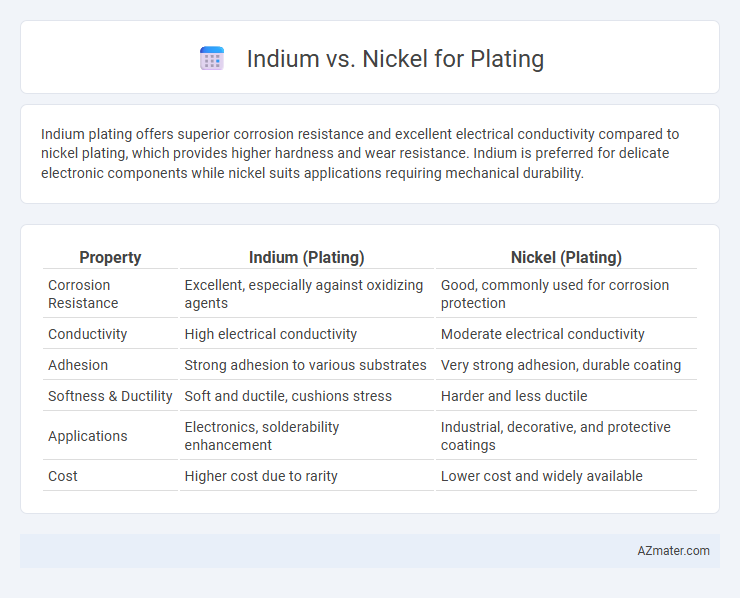Indium plating offers superior corrosion resistance and excellent electrical conductivity compared to nickel plating, which provides higher hardness and wear resistance. Indium is preferred for delicate electronic components while nickel suits applications requiring mechanical durability.
Table of Comparison
| Property | Indium (Plating) | Nickel (Plating) |
|---|---|---|
| Corrosion Resistance | Excellent, especially against oxidizing agents | Good, commonly used for corrosion protection |
| Conductivity | High electrical conductivity | Moderate electrical conductivity |
| Adhesion | Strong adhesion to various substrates | Very strong adhesion, durable coating |
| Softness & Ductility | Soft and ductile, cushions stress | Harder and less ductile |
| Applications | Electronics, solderability enhancement | Industrial, decorative, and protective coatings |
| Cost | Higher cost due to rarity | Lower cost and widely available |
Introduction to Indium and Nickel Plating
Indium plating provides exceptional corrosion resistance and excellent solderability, making it ideal for electronic components and aerospace applications where adhesion and conductivity are critical. Nickel plating offers superior hardness and wear resistance, commonly used in automotive, industrial machinery, and electronic connectors to enhance surface durability and protect against oxidation. Both plating materials serve specialized functions, with indium excelling in delicate, high-performance environments and nickel favored for robust protection and longevity.
Chemical Properties Comparison
Indium exhibits excellent corrosion resistance and a low melting point of 156.6degC, making it highly ductile and suitable for delicate plating applications, while nickel has a higher melting point of 1455degC and offers superior hardness and wear resistance. Indium's chemical inertness provides strong resistance to oxidation in acidic and alkaline environments, whereas nickel forms a passive oxide layer that enhances surface protection against corrosion but can be prone to discoloration. The choice between indium and nickel plating depends on the specific application's requirements for flexibility, environmental exposure, and mechanical durability.
Electrical Conductivity Differences
Indium offers superior electrical conductivity compared to nickel, making it ideal for applications requiring efficient current flow and minimal signal loss. Nickel plating, while corrosion-resistant and durable, has higher electrical resistance, which can impair performance in sensitive electronic components. The choice between indium and nickel plating hinges on balancing conductivity needs against environmental protection and mechanical strength.
Corrosion Resistance: Indium vs Nickel
Indium offers superior corrosion resistance compared to nickel, especially in harsh environments involving acids, alkalis, and saltwater exposure. Nickel plating provides moderate corrosion protection but tends to oxidize and degrade faster under aggressive conditions. Indium's excellent resistance to corrosion makes it ideal for applications requiring long-term durability and exposure to chemically reactive substances.
Adhesion and Surface Finish
Indium plating offers superior adhesion on soft and flexible substrates, creating a uniform, smooth surface finish ideal for sensitive electronic components. Nickel plating provides excellent corrosion resistance and hardness with strong adhesion on rigid, metallic substrates, but may result in a rougher surface finish. Selecting between indium and nickel depends on the specific application requirements for flexibility, durability, and surface smoothness.
Applications in Electronics
Indium plating offers excellent softness, corrosion resistance, and solderability, making it ideal for sensitive electronic connectors and semiconductor components that require reliable electrical contacts. Nickel plating provides superior hardness, wear resistance, and oxidation protection, widely used in printed circuit boards (PCBs) and magnetic materials where durability is essential. Both metals serve critical roles in electronics, with indium enhancing performance in flexible circuits and nickel ensuring longevity in harsh operating environments.
Cost and Availability
Indium plating commands a significantly higher price due to its rarity and limited global production, making it far less cost-effective than nickel. Nickel is widely available and produced in large quantities, contributing to its affordability and extensive use in industrial plating applications. While indium offers superior corrosion resistance and solderability, its premium cost and limited supply restrict its use to specialized applications rather than mass-market plating.
Environmental Impact and Safety
Indium plating offers a lower environmental impact due to its non-toxic properties and reduced hazardous waste compared to nickel, which involves the use of carcinogenic hexavalent chromium in its plating process. Nickel plating generates harmful byproducts and requires stringent handling procedures to protect workers from exposure to toxic chemicals, whereas indium is generally safer for both workers and end-users. Choosing indium over nickel can significantly improve workplace safety and reduce ecological harm associated with metal plating operations.
Plating Process Techniques
Indium plating offers superior adhesion and flexibility compared to nickel, making it ideal for applications requiring enhanced corrosion resistance and electrical conductivity. Nickel plating techniques typically involve electroplating or electroless plating processes, providing a hard, wear-resistant surface mainly used for protective coatings. Indium plating often requires specialized deposition methods such as electroplating with indium sulfate solutions, ensuring uniform layer formation and excellent solderability in electronic components.
Choosing the Right Plating Material
Choosing the right plating material between indium and nickel depends on the application's specific requirements, including corrosion resistance, conductivity, and flexibility. Indium offers excellent softness and oxidation resistance, making it ideal for sensitive electronic contacts and thermal interface materials. Nickel provides superior hardness and wear resistance, suitable for mechanical parts exposed to harsh environments.

Infographic: Indium vs Nickel for Plating
 azmater.com
azmater.com